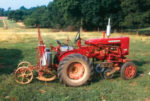Advertise Follow Us
Articles by Frank Lessiter
No-Till’s List of Legends
This roster of influencers has a tremendous legacy on no-till since its modest start in 1962.
Read More
Timeline of the No-Till Revolution
Thousands of small but compounding victories spurred no-till’s growth from 0 to 110 million acres in 60 years.
Read More
Honoring Leaders, Pioneers in the No-Till Community
The 26th class of No-Till Innovators led advancements in no-tilling by championing organic no-till, no-till tobacco, innovative planter attachments, robust educational events and farmer networks.
Read More
No-Till’s First Field
It’s only 7/10ths of an acre separated by a drainage ditch from the rest of a 180-acre field, but it’s been continuously no-tilled for 60 years.
Read More

.png?height=125&t=1731942302&width=150)







